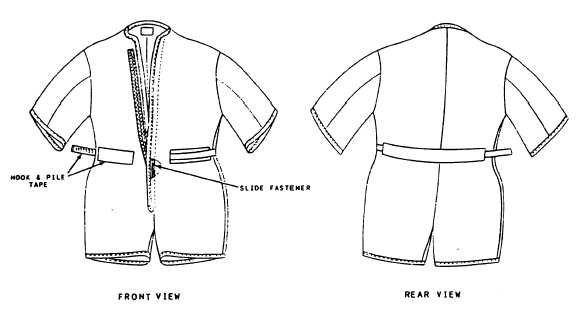Figure 4-7.—CWU-72/P liner.
an inner layer of 100% cotton and an outer layer
of polypropylene netting.
Each sleeve ending has a coated stretch fabric
insert to permit easy insertion of the hands and
to reduce bulk. The leg endings are short enough
to clear the tops of the flight boots, thereby
eliminating bulk. They are notched at the front
to allow standard wool or cotton socks to be
pulled up over the liner legs, and to hold the liner
legs in place when the CWU-62/P coverall is
donned.
CWU-72/P LINER. The CWU-72/P liner
(fig. 4-7) is a one-piece garment and is supplied
in nine sizes. The liner is worn directly under the
CWU-62/P coverall and over the recommended
underclothing. The liner provides a layer of
thermal protection, and is made of 100% olefin
microfiber thermal insulation sandwiched between
two layers of high-temperature resistant Aramid
fabric.
CWU-62/P ANTIEXPOSURE COVER-
ALL.— The CWU-62/P antiexposure coverall
(fig. 4-8) is a one-piece garment and is supplied
in 12 sizes. The coverall should not be worn in
direct contact with the skin. It is a lightweight
coverall that prevents water from entering, but
permits bodily produced moisture vapor to pass
out, thus minimizing heat and moisture buildup.
Proper maintenance is essential to the life and
safety of this coverall, as well as proper sizing and
fitting.
The neck seal and wrist seals are
manufactured from natural rubber and are
flocked on both sides. The entrance opening and
the relief portal are sealed with a water and
pressure-sealing slide fastener.
To fit the CWU-62/P coverall, the neck and
wrist seals may be trimmed at the initial fitting,
but the seals tend to adjust to the aircrew member
after a short period of time. If no excessive seal
restriction exists, and the seal fit is acceptable to
the aircrew member, the seals should be left as
they are. Neck seals need to fit snugly and remain
in direct contact with the neck through all normal
head movements. Wrist seals must fit tightly
enough to prevent water entry, but not tight
enough to restrict blood flow. If seal sizing is
required, proceed as follows:
CAUTION
DO NOT USE A BALL-POINT PEN
OR LEAD PENCIL TO MARK THE
COVERALL MATERIAL. USE ONLY
TAILOR’S CHALK OR A CHINA
MARKING PENCIL.
1. If neck seal trimming is necessary, mark
a line around the circumference of the neck
opening. Trimming increments should not be
more than one-eighth inch at a time.
2. Carefully cut along this line with a sharp
pair of scissors.
4-10

